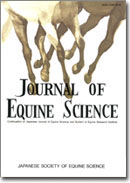All issues

Volume 24 (2013)
- Issue 4 Pages 57-
- Issue 3 Pages 31-
- Issue 2 Pages 17-
- Issue 1 Pages 1-
Volume 24, Issue 2
Displaying 1-2 of 2 articles from this issue
- |<
- <
- 1
- >
- >|
Original Articles
-
Manabu NEMOTO, Keiichiro KIZAKI, Yoshio YAMAMOTO, Toshina OONUMA, Kazu ...2013Volume 24Issue 2 Pages 17-23
Published: 2013
Released on J-STAGE: June 28, 2013
JOURNAL FREE ACCESSIn vitro cell studies might be a useful tool for studying tendon pathology, but no suitable in vitro models exist for tendon disorders. The purpose of this study was to confirm whether cell scratch culture using tendon-derived fibroblasts can provide a suitable in vitro tendon disorder model. Extracellular matrix components were examined immunohistochemically in tendon tissue, and then their related gene expression levels were analyzed by conventional reverse transcription polymerase chain reaction (RT-PCR) and/or quantitative real-time RT-PCR in tissues and cells. Collagen type I (Col I), collagen type III (Col III), tenascin-C (TN-C) and cartilage oligomeric matrix protein (COMP) were detected in tendon tissue sections, and RT-PCR confirmed their expression in tendon tissue and cells. Cells that had been cultured from explanted tendon tissue maintained the characteristics of in vivo tendon cells. The combination of TN-C and COMP might be a useful marker of tendon cells because they display more tendon-specific expression than Col I and III. In particular, the significant increase of TN-C mRNA expression in the scratch wound assay, at 12 hr after scratching, concomitant with the regeneration of the cell sheet, indicates its crucial role in tendon cell proliferation and migration. Thus, TN-C appears to be a key factor in tendon wound healing. In vitro cell scratch assays using tendon cells appear to mimic the repair of tendon tissue after injury.View full abstractDownload PDF (2252K) -
Mitsuo ISHII, Takahiro AOKI, Kazuhiro YAMAKAWA, Fumie MAGATA, Chikara ...2013Volume 24Issue 2 Pages 25-29
Published: 2013
Released on J-STAGE: June 28, 2013
JOURNAL FREE ACCESSThe aim of this study was to clarify the relationship between the placental retention time (PRT) and the reproductive performance following mating at the foal heat in Thoroughbreds. For this purpose, we interviewed 292 farmers over a period of 3 years with questionnaires evaluating foaling, expulsion of placenta and reproductive performance at the foal heat in 1,432 mares. The obtained data were later compared with a previous study of heavy draft mares. The average of the PRT of the 1,432 Thoroughbred mares was 58 ± 88 min (mean ± SD). The mean PRT of Thoroughbreds was significantly shorter than that of the148 min of heavy draft mares. The incidences of retained placenta (RP) occurring in the Thoroughbred mares were 5.2 and 4.0%, for over 3 and 4 hr after foaling, respectively. The incidence of RP over 4 hr was significantly lower than that of 25% in heavy draft mares. The pregnancy rate at foal heat of the mares in which PRT was less than 3 hr was 37%, and it significantly decreased to 11% for those with PRT of more than 3 hr. In the comparison of the reproductive performance between Thoroughbred and heavy draft mares, the pregnancy rate of Thoroughbreds dropped drastically to 10% when PRT exceeded 40, and in consequence, the pregnancy rate of Thoroughbreds was significantly lower than the 30% of heavy draft mares, which had a PRT of over 4 hr. In conclusion, the Thoroughbred mares had a low incidence of RP, however, a PRT exceeding 3 hr severely affected the reproductive performance at the foal heat.View full abstractDownload PDF (882K)
- |<
- <
- 1
- >
- >|